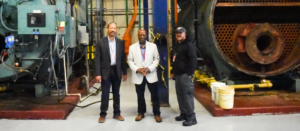
UDC to Receive $63 Million to Improve Central Plant Infrastructure and Equipment Over the Next Six Years
UDC to Receive $63 Million to Improve Central Plant Infrastructure and Equipment Over the Next Six Years

Alex Garrett, Associate Vice President, Facilities & Real Estate Management, Alvin “David” Venson, Director of Facilities and Operations, and Simmie Terrell, Supervisor of Central Plant Operations, who has worked at UDC for more than 40 years.
Most take for granted the mechanical operations that keep UDC’s campuses running smoothly – warm in the winter and cool in the summer.
UDC’s Central Plant, Building 43, serves 10 buildings on the Van Ness Campus and is the hub for 24-hour service managed by a group of engineers, a maintenance team, and contractors.
The University continues to upgrade equipment that needed replacement through recent funding for $63 million over six years, $13.5 million of which was allocated for the 2023 fiscal year.
According to Alex Garrett, associate vice president of Facilities and Real Estate Management, UDC has made progress over the past few years through several capital renovation efforts and continues to upgrade the various systems with individual projects and other space improvements.
Garrett said the infrastructure at the UDC Van Ness Campus has long needed significant upgrades to the HVAC, electrical plumbing, and IT systems. Much of the campus’s infrastructure is well beyond the expected life cycle – with some equipment dating back to the 1970s.
“President Mason played a huge role in getting the funding that we have now, $63 million dollars,” Garrett said. “We’ve had funding previously that we’ve been using, but this is a significant amount that will allow us to pretty much complete the rest of the infrastructure system upgrades, which includes IT as well.”
The department has received funding from the District for upgrades to various projects they have been working on since 2009, but it has never received this level of funding in a budget cycle over six years.
“One of the number one complaints from students and staff is our inability to control temperatures that are too hot in the summer and too cold in the winter,” Garrett said. “That is top on the list of things to address.”
Most Van Ness Campus buildings receive heating and cooling from the Central Plant (Building 43). Within the Central Plant, two high-pressure boilers generate steam for heating distributed to the facilities through steam piping. They convert it into hot water inside mechanical rooms within each building. The hot water runs through coils inside Air Handling Units (AHUs), distributing the heated air throughout the buildings.
This process is duplicated during the cooling season, except that instead of generating steam, chilled water is generated through two 1000-ton centrifugal chillers, also located in the Central Plant, and distributed to the various buildings through a separate chilled water loop.
The Van Ness campus must be manned 24 hours a day because it is a high-pressure plant, and team members are on hand to respond to alerts on the other campus sites. Engineers monitor sensors and do routine rounds throughout the day.
Despite it being stressful sometimes to keep mechanical operations running university-wide, Alvin “David” Venson, director of Facilities and Operations, is proud of being able to keep systems running and for the improvements that will make it even more efficient.
“It’s good work. It feels great to help to make the environment conducive for learning,” said Venson, who has a D.C. HVAC Master License and serves on the Industrial Trade Board for the District. “It can be a thankless job, but it is also gratifying to ensure a level of comfort.”
Venson said the department’s tracking system ensures that service requests are met on the Van Ness Campus and maintains service for the Law School and UDC Community College. He also credits the Maintenance Division for supporting the approximately 1.3 million square feet of campus properties that must be maintained.
In 2016, a comprehensive assessment of the HVAC infrastructure at the Van Ness campus was completed, and generated recommendations and cost estimates for renovating the mechanical, electrical, and plumbing systems (MEP).
The estimate at that time was $63 million. It included two significant recommendations: Phase out the high-pressure boilers and central steam distribution loop by installing local boilers in each building, allowing it to re-purpose space inside the plant. The other recommendation was to continue using the existing chilled water system and renovate all mechanical rooms with new Air Handling Units.
Previous upgrades have included replacing the Building 38 mechanical systems on levels 1, 2, and 3 for the Business School renovation in 2014 and system upgrades in Building 32 and 42 for the School of Architecture Renovation on Level 2.
More recent upgrades have also included replacing Air Handling Units and upgrading distribution equipment in Building 39 Level 2 and for the Dr. E.B. Henderson Sports Complex
Main Gym area. The upgrade in the Sports Complex also included the installation of new High-Efficiency Boilers, which follows the recommendations of the 2016 assessment to eliminate the need for the central steam system eventually.
The team is working on HVAC/Mechanical, Electrical, and Plumbing (MEP) upgrades in Building 38 and 39 Level B for the Main Library renovation. The next phase of upgrades to HVAC/MEP systems in Buildings 39 and 44 are in the design stage and will be done in conjunction with various space renovations beginning in FY24.